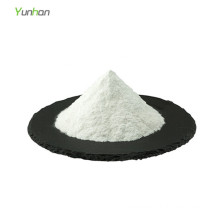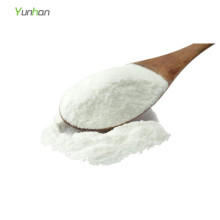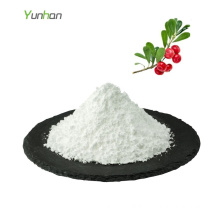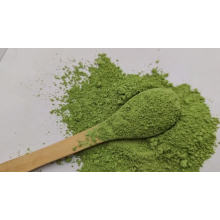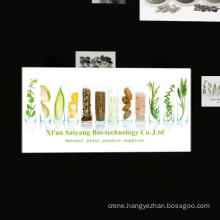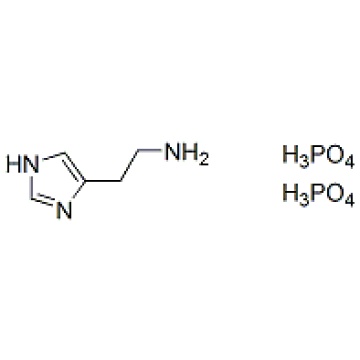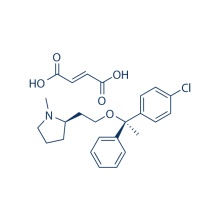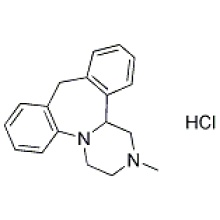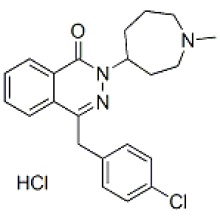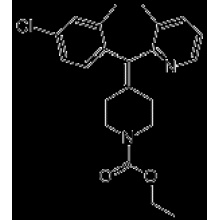Histamine Phosphate 51-74-1
Product Description
.cp_wz table {border-top: 1px solid #ccc;border-left:1px solid #ccc; } .cp_wz table td{border-right: 1px solid #ccc; border-bottom: 1px solid #ccc; padding: 5px 0px 0px 5px;} .cp_wz table th {border-right: 1px solid #ccc;border-bottom: 1px solid #ccc; padding: 5px 0px 0px 5px;}
Molecular Weight: 307.14 Histamine acts directly on the blood vessels to dilate arteries and capillaries mediated by both H 1- and H 2-receptors.
Histamine (10 μM) gives a larger inositol monophosphate accumulation in
bovine adrenal chromaffin cells. Histamine (10 μM) stimulates the level
of radioactivity into the InsP3-containing fraction in bovine adrenal
chromaffin cells. Histamine (100 μM) stimulates incorporation into the
InsP3-containing eluate in a less extent than for angiotensin I1 and
bradykinin.
Histamine phosphate (0.025 mg/kg) produces a mean increase in basilar
blood flow of 145% of control in dogs. Histamine phosphate produces
considerable increases in basilar blood flow as well as a decrease in
femoral arterial blood pressure in dogs when injected intravenously and
measured with an electromagnetic flow transducer. Histamine phosphate (4 μg/kg) causes lymph flow to increase from 6.0 to
27.0 (SEM) ml/h in unanesthetized sheep. Histamine phosphate (4 μg/kg)
also causes increases in lung water, pulmonary vascular resistance,
arterial PCO2, pH, and hematocrit, and decreases in cardiac output and
arterial PO2 in unanesthetized sheep.
Histamine phosphate
(8.3 mg/kg/min) causes no significant change in pulmonary lymph flow
(QL) or protein concentration (CL) in anesthetized open-chested dogs,
however, both are increased after alloxan. Histamine phosphate (8.3
mg/kg/min) also causes no significant change in the pulmonary capillary
membrane filtration coefficient (Kf) and the maximum capillary pressure
(PCcritical) in anesthetized open-chested dogs. Histamine
phosphate (50 mg/kg) produces a pronounced rise in acid secretion but
the output of pepsin remained unchanged in the unanaesthetized intact
rat. Histamine phosphate (50 mg/kg) produces maximal stimulation of
gastric acid secretion and is free from toxic effects in the
unanaesthetized intact rat.
Conversion of different model animals based on BSA (Value based on data from FDA Draft Guidelines)
For example, to modify the dose of resveratrol used for a mouse (22.4 mg/kg) to a dose based on the BSA for a rat, multiply 22.4 mg/kg by the Km factor for a mouse and then divide by the Km factor for a rat. This calculation results in a rat equivalent dose for resveratrol of 11.2 mg/kg.
Contact us if you need more details on 51-74-1. We are ready to answer your questions on packaging, logistics, certification or any other aspects about 51-74-1 Histamine Phosphate、Histamine Phosphate 51-74-1. If these products fail to match your need, please contact us and we would like to provide relevant information.
Molecular Weight: 307.14 Histamine acts directly on the blood vessels to dilate arteries and capillaries mediated by both H 1- and H 2-receptors.
Histamine (10 μM) gives a larger inositol monophosphate accumulation in
bovine adrenal chromaffin cells. Histamine (10 μM) stimulates the level
of radioactivity into the InsP3-containing fraction in bovine adrenal
chromaffin cells. Histamine (100 μM) stimulates incorporation into the
InsP3-containing eluate in a less extent than for angiotensin I1 and
bradykinin.
Histamine phosphate (0.025 mg/kg) produces a mean increase in basilar
blood flow of 145% of control in dogs. Histamine phosphate produces
considerable increases in basilar blood flow as well as a decrease in
femoral arterial blood pressure in dogs when injected intravenously and
measured with an electromagnetic flow transducer. Histamine phosphate (4 μg/kg) causes lymph flow to increase from 6.0 to
27.0 (SEM) ml/h in unanesthetized sheep. Histamine phosphate (4 μg/kg)
also causes increases in lung water, pulmonary vascular resistance,
arterial PCO2, pH, and hematocrit, and decreases in cardiac output and
arterial PO2 in unanesthetized sheep.
Histamine phosphate
(8.3 mg/kg/min) causes no significant change in pulmonary lymph flow
(QL) or protein concentration (CL) in anesthetized open-chested dogs,
however, both are increased after alloxan. Histamine phosphate (8.3
mg/kg/min) also causes no significant change in the pulmonary capillary
membrane filtration coefficient (Kf) and the maximum capillary pressure
(PCcritical) in anesthetized open-chested dogs. Histamine
phosphate (50 mg/kg) produces a pronounced rise in acid secretion but
the output of pepsin remained unchanged in the unanaesthetized intact
rat. Histamine phosphate (50 mg/kg) produces maximal stimulation of
gastric acid secretion and is free from toxic effects in the
unanaesthetized intact rat.
Conversion of different model animals based on BSA (Value based on data from FDA Draft Guidelines)
| Species | Baboon | Dog | Monkey | Rabbit | Guinea pig | Rat | Hamster | Mouse |
| Weight (kg) | 12 | 10 | 3 | 1.8 | 0.4 | 0.15 | 0.08 | 0.02 |
| Body Surface Area (m2) | 0.6 | 0.5 | 0.24 | 0.15 | 0.05 | 0.025 | 0.02 | 0.007 |
| Km factor | 20 | 20 | 12 | 12 | 8 | 6 | 5 | 3 |
| Animal A (mg/kg) = Animal B (mg/kg) multiplied by | Animal B Km |
| Animal A Km |
For example, to modify the dose of resveratrol used for a mouse (22.4 mg/kg) to a dose based on the BSA for a rat, multiply 22.4 mg/kg by the Km factor for a mouse and then divide by the Km factor for a rat. This calculation results in a rat equivalent dose for resveratrol of 11.2 mg/kg.
| Rat dose (mg/kg) = mouse dose (22.4 mg/kg) × | mouse Km(3) | = 11.2 mg/kg |
| rat Km(6) |
Contact us if you need more details on 51-74-1. We are ready to answer your questions on packaging, logistics, certification or any other aspects about 51-74-1 Histamine Phosphate、Histamine Phosphate 51-74-1. If these products fail to match your need, please contact us and we would like to provide relevant information.
Product Categories : Neuronal Signaling > Histamine Receptor Inhibitor
Other Products
Hot Products
Astragaloside AChlortetracycline HCl 64-72-2Paclitaxel 33069-62-4Dexamethasone Acetate 1177-87-3Dinaciclib (SCH727965) 779353-01-4CHIR-124 405168-58-3Ro3280 1062243-51-9TAME 901-47-3CCG-1423 285986-88-110058-F4 403811-55-2Dabigatran (BIBR 953) 211914-51-1H 89 2HCl 130964-39-5T0901317 293754-55-9Aprepitant 170729-80-3Turofexorate Isopropyl (XL335) 629664-81-9BMS-378806 357263-13-9

